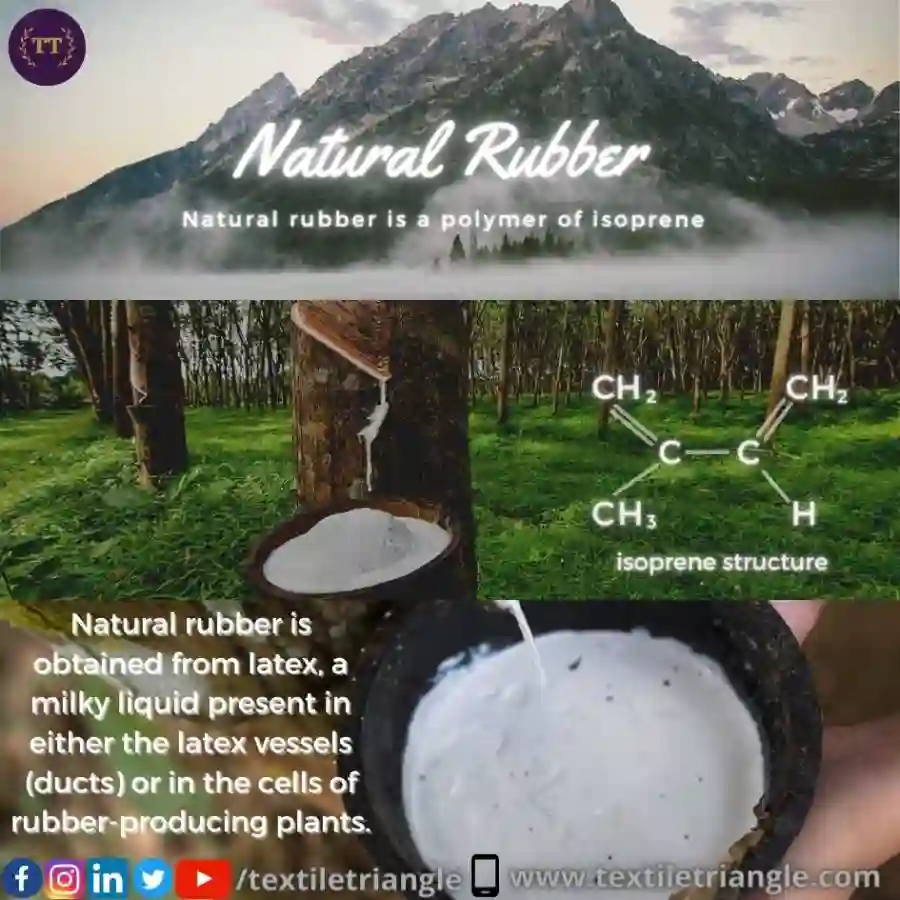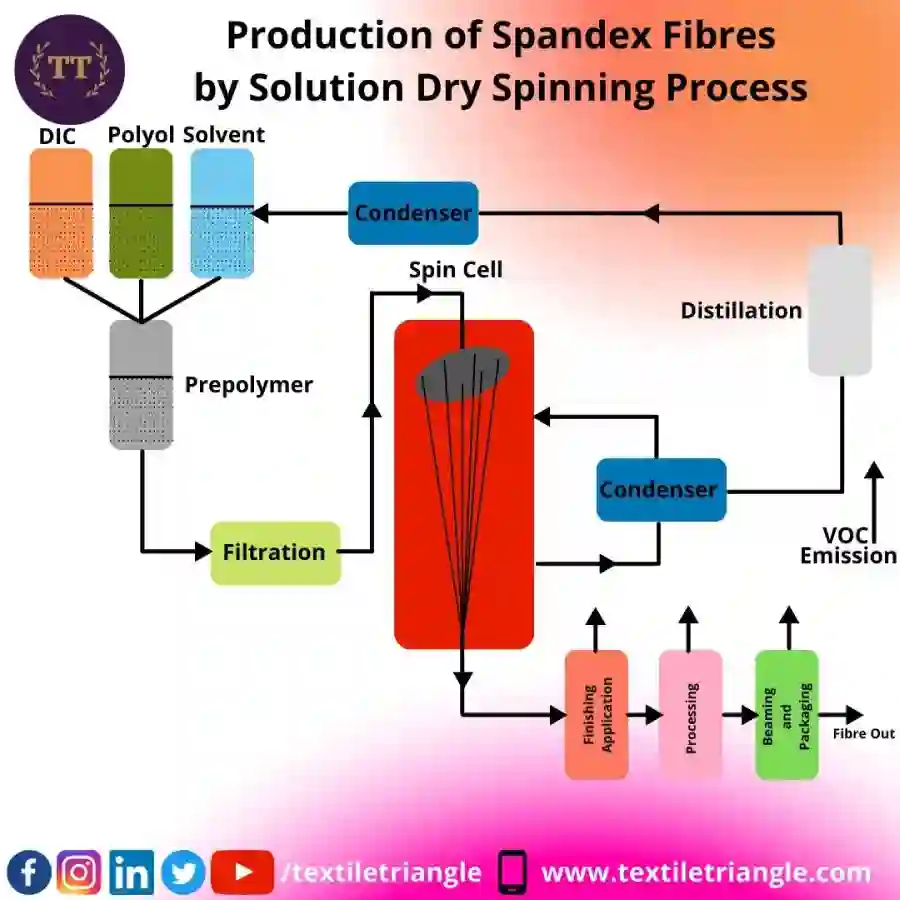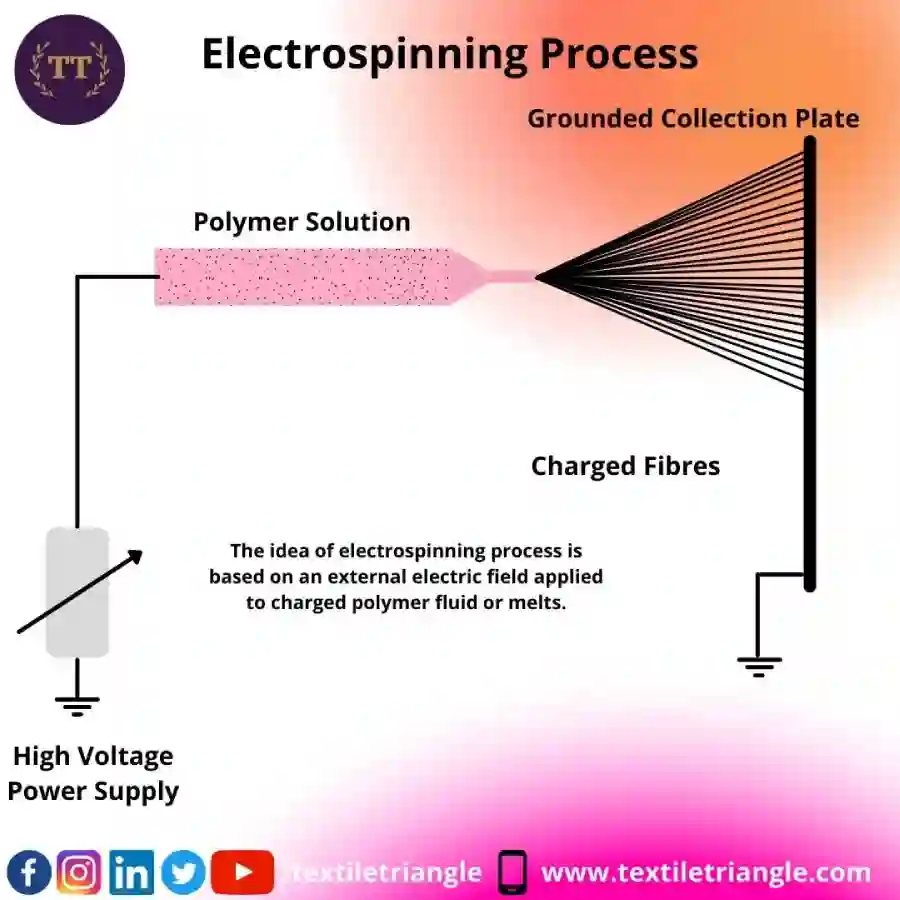Table of Contents
Introduction
An elastomer is a polymer with the physical property of elasticity. Elastomer is a term derived from elastic polymer, which is often used interchangeably with the term rubber. Each of the monomers which link to form the polymer usually made of carbon, hydrogen, oxygen and / or silicon.
Elastomeric fibers are those fibers that possess extremely high elongation at break and that recover fully and rapidly from high elongations up to their breaking point. Elastomers are natural or synthetic materials which are used for improving the elastic properties of the clothing/yarn and other materials.
Elastomeric fibres, known as elastanes in Europe and Spandex in America.
Elastomeric Fibers
Elastomeric fibers are those which have mechanical properties characteristics of natural rubber: they can be stretched to several times their original length and on release will snap back quickly to recover their original length almost completely.
Natural rubber filaments have been used in textile industry for many years, they impart a high degree of stretch and recovery to support and foundation garments, elastic webbing etc. However, natural rubber has several disadvantages with respect to its use as a textile filament, and an elastomeric fiber superior to rubber in recovery to abrasion has long been sought.
Spandex: Spandex term is widely used in USA. Spandex is a manufactured fibre in which fiber-forming substance is a long-chain synthetic polymer composed of at least 85% of a segmented polyurethane. The term spandex is thus based on the chemical structure of the fiber, whereas the term elastomeric fiber relates to the rubber-like characteristics of the fiber.
Natural Rubber Fibres
Rubber is a natural polymer obtained by coagulation of latex produced by certain species of plant, mainly rubber plant (Hevea Brasiliensis) which grows in tropical regions.

Processing of Natural Rubber
In its raw state rubber is tough, elastic material which softens on heating, becoming plastic and dough-like. In the processing of rubber, it is kneaded and mixed in powerful mills. This softens the rubber, making it more thermoplastic and largely destroying the elasticity of the raw polymer.
Also, at the same time, milling provides an opportunity for mixing other materials into the rubber, notably sulphur which takes part in the subsequent process of vulcanization or curing.
When this mixture is heated, the rubber reacts with sulphur and sets in the moulded shape. By this process rubber acquire unusual elasticity, because of vulcanization of rubber. A cured or vulcanized rubber may stretch to many times its original length, and will return to that length when the stretching force is removed.
Production of Rubber Filaments
A. Cut Rubber Filaments: The rubber latex is coagulated, and the raw rubber is mixed with vulcanizing agents and other ingredients on a mill. It is then passed through a calender, which produces a thin sheet of very accurately controlled dimensions. The sheet may be cut into filaments before or after vulcanization.
B. Extended Rubber Filaments: Rubber latex is mixed with vulcanizing agents, accelerators, antioxidants, pigments and other materials and is extruded through glass spinnerets into a coagulating bath, commonly of acetic acid. The jets of latex coagulate, and the filaments are washed, dried and heated to bring about vulcanization of the rubber. The filaments are thus converted into fine, highly-elastic threads, which are dusted with talc to provide a smooth surface which facilitates processing.
Properties of Natural Rubber Fibres
- Natural rubber is a polymer of isoprene in which the isoprene units are arranged in the cis configuration.
- There are around 10,000 isoprene units in the chain molecule. The rubber like behavior of rubber is due to the unusual form of its molecules, which are highly folded, so that when a piece of rubber is pulled the molecules tend to straighten out and then return to their folded configurations on release of the strain.
- The kind of vulcanized rubber used for elastomeric fibres has a modulus at 500% extension of about 0.7 g/tex.
- Natural rubber is resistant to most inorganic acids but is attacked by concentrated sulphuric acid and by oxidizing acids such as nitric acid chromic acids.
Spandex Fibres
‘Lycra’ was the first spandex fibre to achieve commercial success. Polyurethane fiber (Spantex or Elastane) is a synthetic fibre know for its exceptional elasticity. Spandex is stronger, lighter and more versatile and durable than rubber. Spandex fibers can be stretched to almost 500% of their length.
Properties of Spandex Fibres
- superior oxidation resistance
- Excellent resistance to dry-cleaning solvents
- Good dyeability
- Excellent retention of properties after exposure to ultraviolet light
- Excellent toughness that avoids the need for fibre protection during knitting
- The fiber properties can be controlled by varying the ratio of the monomers and the lengths of the hard and soft segments.
- The density of spadex filaments ranges from 1.15 to 1.32 g/cc.
- The moisture regain of fibres form which finish has been removed lies between 0.8 and 1.2%.
- The strengths of fibre spandex yarns range from 6 to 9 g/tex, and breaking extension from 500 to 600%.
- Elastic recovery of spandex yarns decreases with increase in the imposed extension.
Production of Spandex Fibres
There are four traditional thermoplastic elastomer types that can be used to produce elastomeric fibers, i.e., 1. polyurethanes, 2. polyester copolymers, 3. styrene copolymers, and the 4. olefinics.
A. Solution Dry Spinning Method
The first step involves the chemical reaction of the monomers to produce prepolymer. The resulting prepolymer undergoes further reaction in various ways and is subsequently drawn out to produce a long fibre. Solution dry spinning is used to produce the main industrial products of Spandex (i.e. up to 90% of the world’s Spandex fibers are dry-spun from solution).

- In this method the production of the Prepolymer is done initially by mixing polyol with a diisocyanate (DIC) monomer. The reactants are mixed in a reaction vessel and under the right conditions they react to form a prepolymer. Because the ratio of the component materials produces fibres with varying characteristics, it is strictly controlled. A typical ration of polyol to diisocyanate may be 1:2.
- The prepolymer is further reacted with an equal amount of diamine to increase the molecular weight in a chain extension step. The resulting solution is diluted with a solvent (THF) to produce the spinning solution.
- The spinning solution is pumped into a cylindrical spinning cell where it is cured and subsequently converted into the fibres. In the spinning cell, the polymer solution is forced through a metal plate with small holes called a spinneret. This production step causes the solution to be aligned into strands of liquid polymer.
- As the strands pass through the cell, they are heated in the presence of nitrogen and solvent gas, making the liquid polymer to chemically react and form solid strands. Specific amount of the solid strands are bundled together as the fibres exit the cell to produce the desires thickness.
- A compressed air device is normally used to twist the fibres together. Each fibre of Spandex is made up of many small individuals fibres that adhere to one another due to the natural stickiness of their surfaces.
- The fibres are then treated with a finishing agent such as magenesium sterate or another polymer such as poly(dimethly siloxane). These finishing materials prevent the fibres from sticking together.
B. Electrospinning Method
The polyurethane (PU) fibres can also be produced via the electrospinning process. In this method fibre properties depend on
1. Electric field strength
2. Distance between the nozzle and collector.
The idea of electrospinning process is based on an external electric field applied to charged polymer fluid or melts. This electric field leads to electric charge on the polymer surface that overcame the surface tension, and consequently a jet is produced. This electrical force can also lead to a very thin jet as it travels. In this case of polymer fluid, the common organic solvent is evaporated extremely fast (millisecond timescale) to produce electrically charged nanofibres.

The technique is valid only for charges polymer solutions or melts with sufficient molecular entanglements. In the electrospinning process, a charged droplet of solution suspended at the end of a capillary deforms into a conical shape, or Taylor cone, when subjected to a Coulombic force.
A jet of low molecular weight fluid breaks up into small droplets, a phenomenon termed electrospraying, while a polymer solution with sufficient chain overlap and entanglements does not break up but undergoes the so-called bending instability that causes a whiplike motion between the capillary tip and the grounded target. This process normally produces fibre with diameters of nanometers to submicometers. Fibres with ranges of diameters less than 100nm are very difficult to obtain from other conventional fibre production technique.
Application / Uses of Elastomeric Fibres
- Apparel: Athletic apparel, swimwear, underwear, lingerie, foundation garment, hosiery, normal clothing, belts, warp knit fabrics for corsetry and sundry applications.
- Automative: Body fasteners, electrical boots, suspension system parts, seals and gaskets, taillight assemblies, air bag covers, transmission boots.
- Adhesive and Sealants: Shoes, aerospace, construction works, laminated security glazing.
- Coatings: Floor, roof, wire and cable, fibre optics, pipes.
- Engineering Components: Gears, printer rolls, belts, wheels, forks lift tyres, escalator wheels.
- Industrial: Lined pipe, water valves, pump impellers, hopper car liners, cattle tags
- Sports: Roller Wheels, Ski boots, bicycle tires, horseshoes, athletic shoes.
- Home furnishing: Micro-bend pillows.
Application of Polyurethane fibres / Spandex fibres
- Medical implants
- Cable and marine ropes
- Sail cloth
- Fish netting
- Concrete reinforcement
- Protective clothing
- Geotextile applications
- Filtration devices
- membranes
- Optics
- Vascular grafts
- Protective clothing
- Molecular templates
- Tissue scaffolds
Frequently Asked Questions | FAQs
What is an elastomeric fiber?
An elastomeric fiber is a type of synthetic fiber that possesses elastic properties, meaning it can stretch and then return to its original shape. These fibers are known for their high elasticity, durability, and ability to provide stretch and recovery in fabrics. Elastomeric fibers are commonly used in various applications, including sportswear, swimwear, lingerie, hosiery, and medical garments, where stretch and comfort are desired. Examples of elastomeric fibers include spandex (also known as Lycra or elastane) and rubber-based fibers.
What is elastomeric fiber example?
One common example of an elastomeric fiber is spandex, also known as Lycra or elastane. Spandex is a synthetic fiber that exhibits exceptional stretch and recovery properties. It can be stretched significantly without losing its shape and can return to its original form once the tension is released. Spandex is widely used in various applications, including athletic wear, swimwear, underwear, leggings, and form-fitting garments, to provide stretch, comfort, and shape retention.
What is elastomeric fiber used for?
Elastomeric fibers, such as spandex (also known as Lycra or elastane), have several uses due to their unique stretch and recovery properties. Some common applications of elastomeric fibers include:
Apparel: Elastomeric fibers are widely used in the apparel industry to provide stretch, comfort, and shape retention in garments. They are commonly found in sportswear, activewear, swimwear, underwear, leggings, and form-fitting clothing.
Medical Garments: Elastomeric fibers are utilized in medical garments, such as compression stockings or sleeves, to provide a snug and supportive fit. The stretch and compression properties of these fibers can aid in improving circulation and reducing swelling.
Hosiery: Elastomeric fibers are commonly used in the production of hosiery items like socks, tights, and stockings. These fibers help maintain the shape and fit of the hosiery, providing stretch and preventing sagging.
Bandages and Wraps: Elastomeric fibers can be incorporated into bandages and wraps to provide compression and support for injuries or medical conditions. They help secure the bandage in place and provide flexibility for movement.
Industrial and Technical Textiles: Elastomeric fibers find applications in industrial and technical textiles, such as automotive textiles, upholstery, and flexible materials for various industries. Their stretch and resilience properties make them suitable for specific requirements in these fields.
Elastomeric fibers are valued for their ability to add elasticity, flexibility, and comfort to a wide range of products across different industries.
What is spandex made of ?
Spandex, also known as elastane or Lycra (a brand name), is a synthetic fiber known for its exceptional elasticity. It is made from a long-chain synthetic polymer called polyurethane. Spandex fibers can stretch up to five times their original length and then return to their original shape without losing elasticity. This makes spandex a popular choice in clothing, particularly in garments that require stretch and recovery, such as athletic wear, swimwear, and form-fitting clothing.
